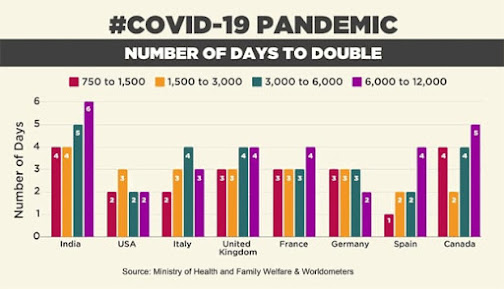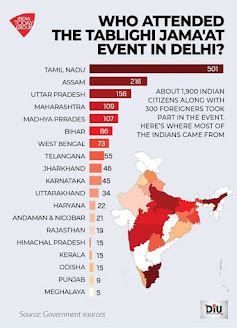
Statistics and governments
Since the onset of COVID-19, it is routine that the media displays national and global numbers of coronavirus cases. Often, these are in catchy graphics. Much like cricket scores of a live match. Television headlines broadcast half-hourly information. Social media platforms like twitter are abuzz about the latest count. The ministry of health affairs earlier would put out daily figures at 4 pm press conferences. This has now been replaced by morning release of official numbers.
Official numbers are usually taken as indisputable (Antonelli 2016). However, statistics are not untouched by socio-political processes. Statistics or rather the maker of particular statistics have more often than not a particular agenda in mind. It, therefore, hints at a correlation between the governance system and numbers.
In the Indian scenario, such politics of numbers in terms of census and enumeration have been studied by different scholars, particularly during the colonial rule. Bernard Cohn (1987) had connected colonialism to practices of information gathering and the standardization and simplifications of social, cultural, and religious codes.
Numbers, however, when used for self-enumeration can also be used by different communities to organise themselves with a stated collective identity (Appadurai 2012). Numbers, therefore, no matter how abstract, have power over the material lives of the different communities. Appadurai (1994) explains how numbers played an important role in colonial imagination and helped shape the nature and extent of communities in the mind of the people. This had tangible expressions in the present as in the Ram janambhoomi and the anti-Mandal agitation.
Health, statistics, and othering
It is often seen in case of diseases, particularly contagious ones like HIV, Tuberculosis, dominant communities tend to attribute its spread to people seen as the ‘other’; in most cases marginalized and minority groups. Such identities are socially constructed and do not have a specific medical basis for attribution (Taylor 2013). In the case of coronavirus, because of its suspected origin in China’s Wuhan, people from Asia became the target of increased racism. In mainland India, such an attitude was seen against those from the north-east. A disturbing incident took place in Delhi when an MPhil Research scholar from Manipur was spit upon by a man and called corona.[i]
The focus of this article however is the Tablighi Jamaat congregation, which many media outlets defined as a super spreader event of the novel coronavirus. The Tablighi Jamaat congregation took place on 15th March in Delhi, and it was actively propagated that the people who attended the congregation were responsible for spreading the virus across the country.

What role did numbers play in facilitating this association of the disease with identity? A large number of state governments started listing out coronavirus cases related to the Tablighi Jamaat incident separately. The health ministry data at the beginning of April claimed that because of the congregation, the doubling rate of the disease was 4.1 days as opposed to the estimated 7.4 days. An April 6th newspaper report said, that out of 4056 cases, 1445 was linked to Tablighi Jamaat congregation.[ii] Another report from 18th April said that the ministry had linked 30% of coronavirus cases in the country to the event.[iii] Some state governments also followed this distinction in giving out data. Uttar Pradesh addition chief secretary around the same time also put out figures, distinguishing between the total numbers of corona cases in the state and separately giving out those cases connected with Tablighi Jamaat congregation.[iv]
Impact of ‘othering’ on communities
There was a sampling bias too in the initial reports. People who attended the congregation were tested in higher numbers. The overall testing of the population remained low.[v] As late as May, some states continued to blame the congregation for the increase in corona cases. It did not seem to matter that many of the cases were unrelated to the congregation. The Jamaat President stated that the initial targeting created an atmosphere of hatred towards Muslims in the country[vi]. Fake and unverified news started spreading about how the Jamaat members were spreading coronavirus as well as unrest in the country. This news was broadcasted by some of the most-watched national channels [vii] and spread like wildfire in social media. Such representation of communities saw widespread criticism, including international ones, forcing the central government and its several agencies to put out official statements to counter such prejudices.[viii]
Yet, the reaction on the ground had already had tragic consequences. It exacerbated the existing communal divide in the country. There were several incidents where Muslims, even those unrelated to the Jamaat congregation became targets of taunts and often violence. Muslims across the country faced increased ostracization from the Hindus[ix]. In a recent clash of two groups in West Bengal, Muslims claimed they were called ‘corona’ when they went out on the street[x].
Over a period of time-specific numbers stop mattering. Vague terms such as ‘many’, ‘a large number’, and so on took over. Numbers, thus lend itself to different uses, but perhaps one use of number which does not become immediately visible is its role as markets of communities, strengthening already existing fault lines in society
Numbers help make ‘concrete’ the effect of a pandemic. It becomes a tool for highlighting the misery of people. But it also renders individual cases invisible. In this case, numbers played an important role in blaming the disease on the ‘other’ community. In the context of growing Islamophobia, it is easy to attribute the disease to the ‘other’, not simply in terms of religion, but also in terms of class such as blaming domestic helps, security guards, migrants for any COVID-19 case. The pandemic has indeed revealed the structure of societies.
References:
1. Antonelli, F. (2016). Politics of numbers: Sociological perspectives on official statistics. International Review of Sociology, 26(3), 351-353.
2. Appadurai, A. (1994). Number in the colonial imagination (C. A. Breckenridge & P. V. Veer, Eds.). In Orientalism and the postcolonial predicament: Perspectives on South Asia. Delhi: Oxford University Press.
3. Appadurai, A. (2012). Why enumeration counts. Environment and Urbanization, 24(2), 639-641.
4. Taylor, R. C. (2013). The politics of securing borders and the identities of disease. Sociology of Health & Illness, 35(2), 241-254.
[i] https://www.news18.com/news/india/he-spat-and-called-me-corona-racism-against-north-east-indians-feeds-off-coronavirus-panic-2549223.html, accessed on 7th June 2020.
[ii] https://www.thehindubusinessline.com/news/1445-cases-linked-to-tablighi-jamaat-event-total-cases-rise-to-4067-death-toll-109/article31271201.ece , accessed on 7th June 2020.
[iii] https://www.livemint.com/news/india/30-covid-19-cases-in-india-linked-to-tablighi-jamaat-event-govt-11587218560611.html, accessed on 7th June 2020.
[iv] https://thewire.in/government/up-govt-coronavirus-cases-tablighi-jamaat, accessed on 7th June 2020.
[v]https://scroll.in/article/958392/explained-sampling-bias-drove-sensationalist-reporting-around-tablighi-coronavirus-cases , accessed on 7th June 2020.
[vi] https://zeenews.india.com/india/1640-foreign-tablighi-jamaat-members-were-in-india-only-66-contracted-covid-19-jamiat-2283943.html, accessed on 7th June 2020.
[vii] https://thewire.in/communalism/bareilly-tablighi-jamaat-media-reports, accessed on 7th June 2020.
[viii] https://scroll.in/article/959806/covid-19-how-fake-news-and-modi-government-messaging-fuelled-indias-latest-spiral-of-islamophobia, accessed on 7th June 2020.
[ix] https://www.nytimes.com/2020/04/12/world/asia/india-coronavirus-muslims-bigotry.html , accessed on 7th June 2020.
[x] https://www.thequint.com/coronavirus/west-bengal-news-coronavirus-telinipara-communal-violence-stigma-burnt-bengal-locality, accessed on 7th June 2020.
(Riona Basu is an MPhil student at the Centre for the Studies in Social Systems (CSSS), Jawaharlal Nehru University (JNU), New Delhi.)
